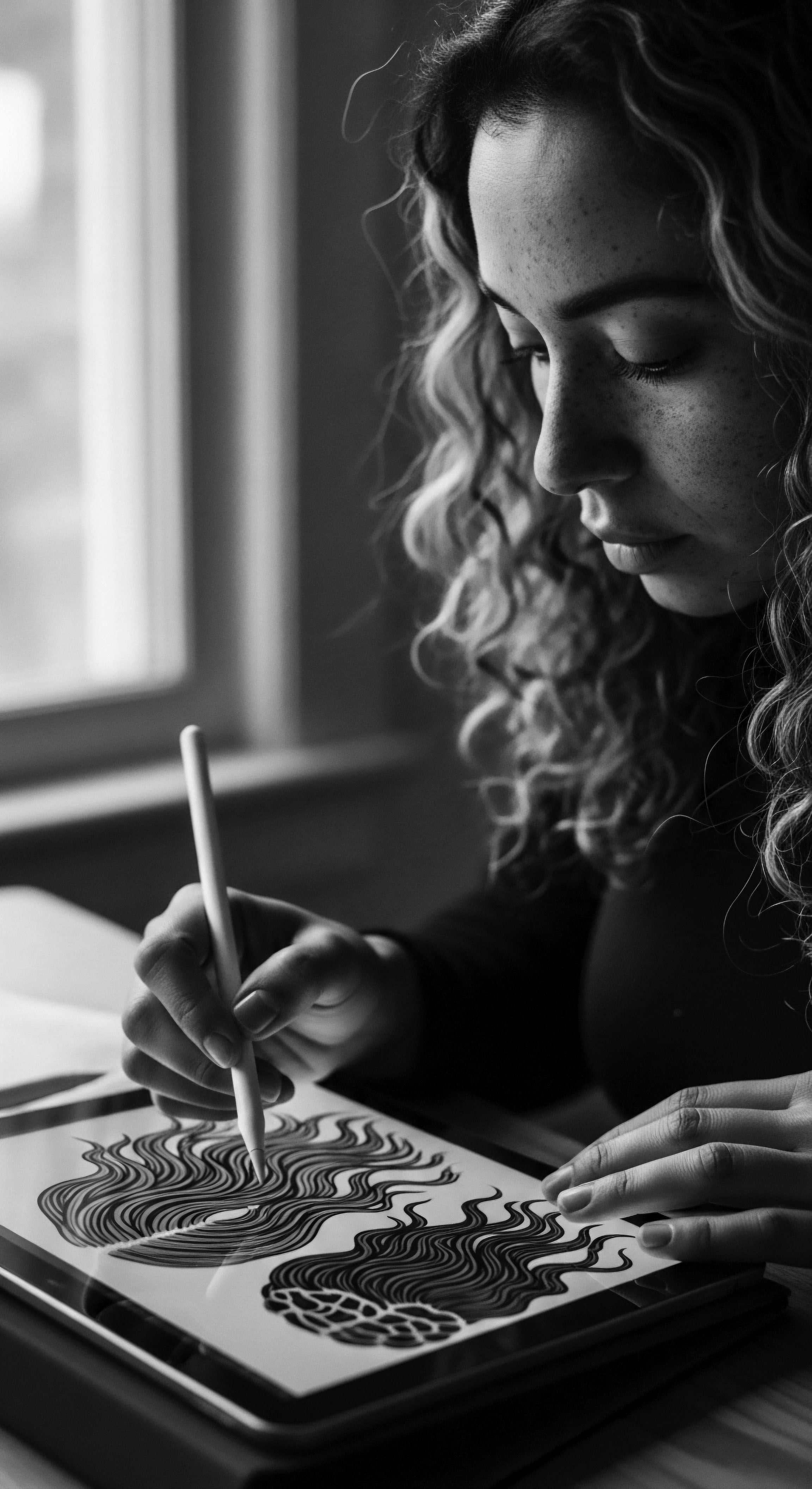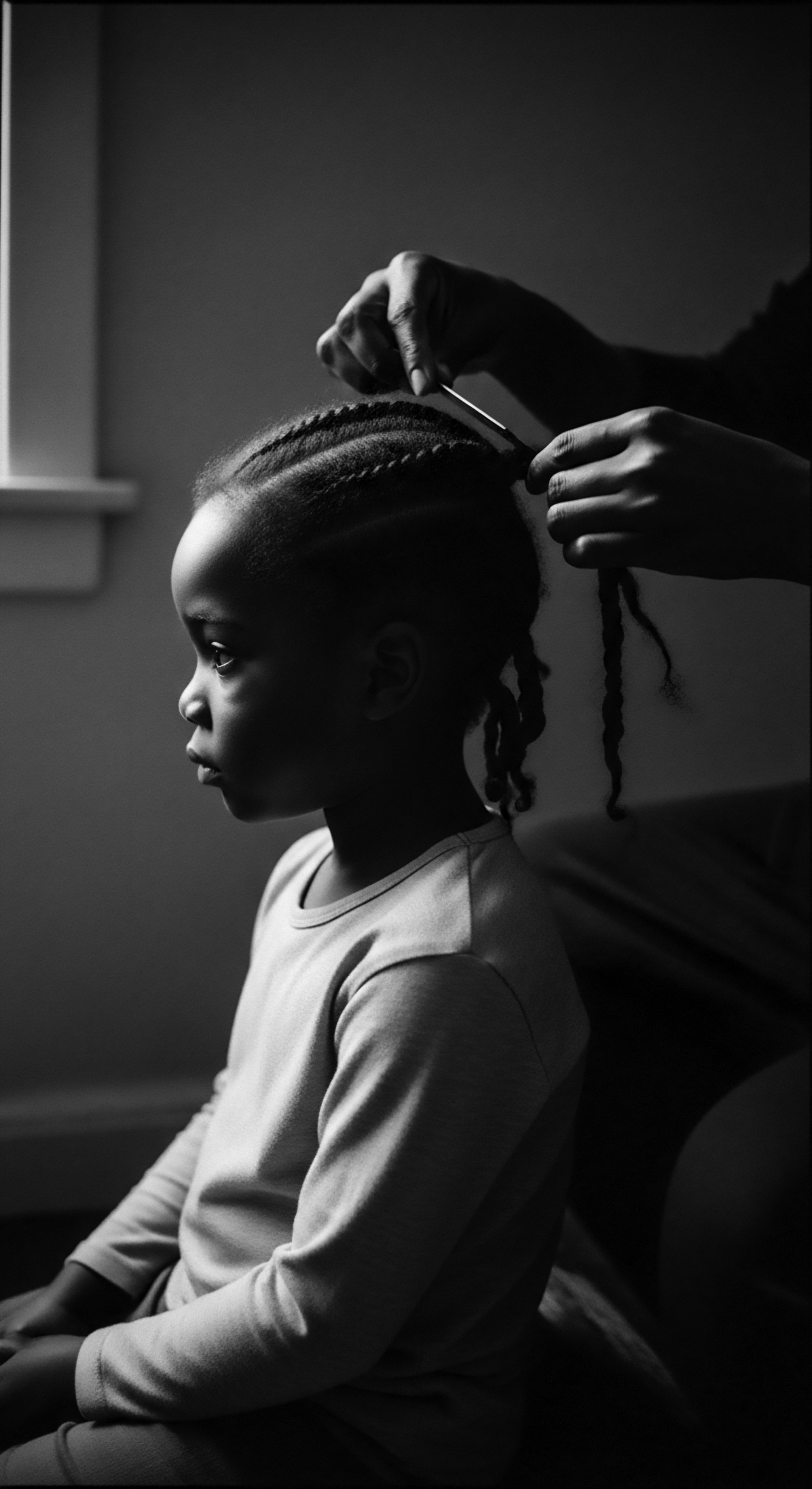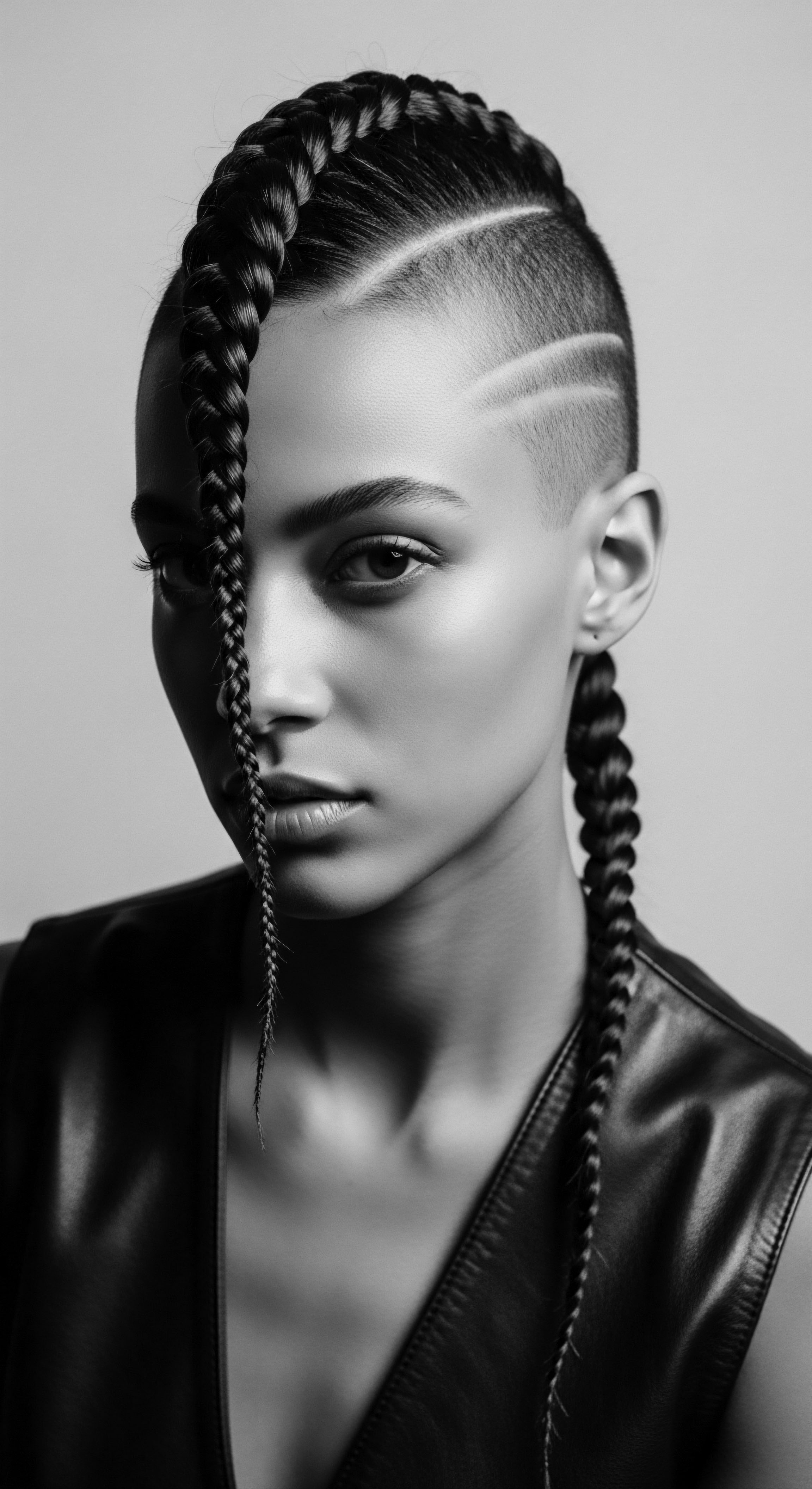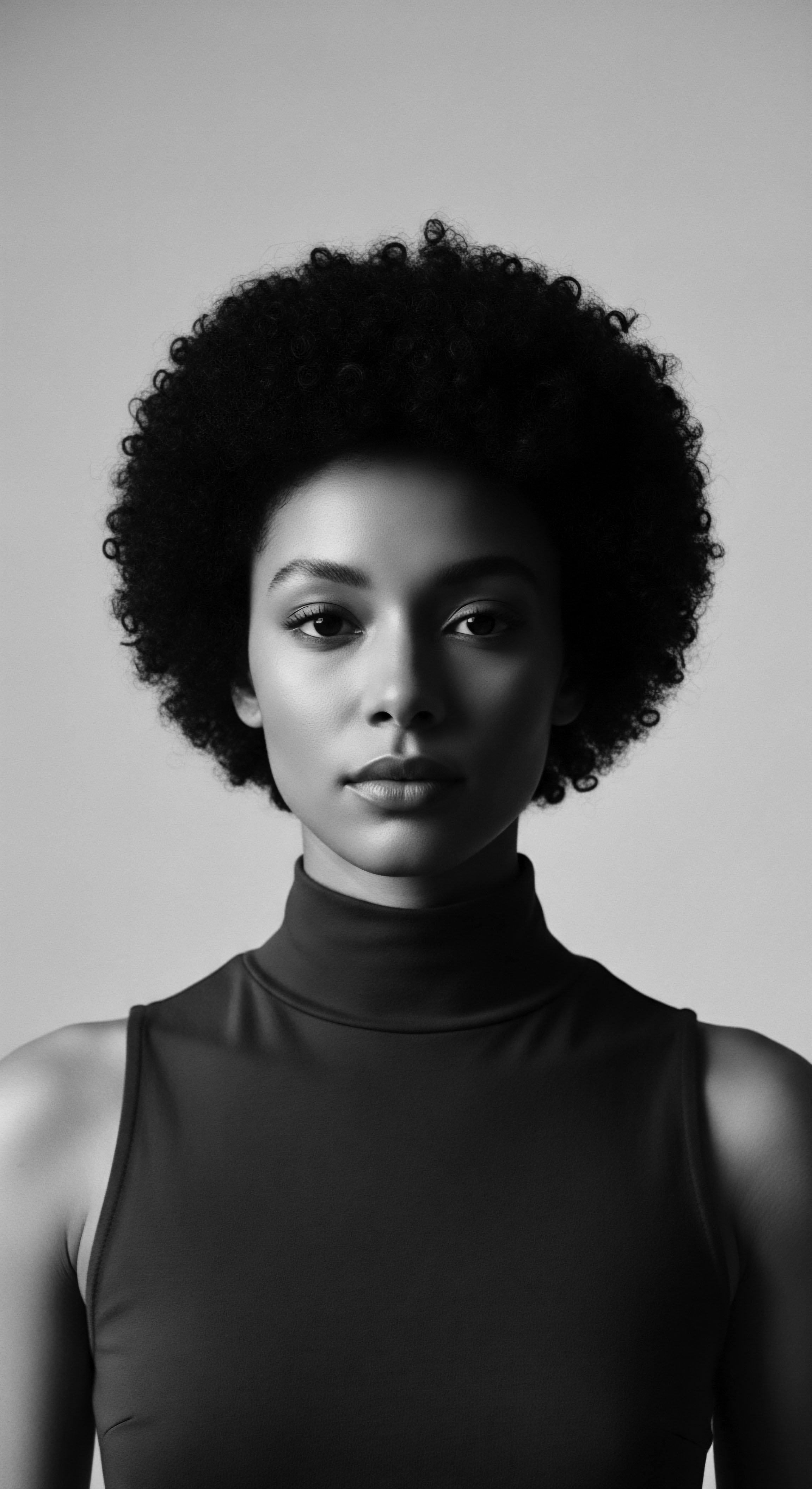
Fundamentals
The concept of “Arid Regions” may initially bring to mind vast, sun-baked landscapes with scarce water, a picture of harshness and stark beauty. For our contemplation of textured hair heritage, this definition deepens considerably, moving beyond simple geography to embody a spectrum of environmental challenges and the ingenious human responses they inspired across millennia. It delineates areas experiencing extreme dryness, where the air itself hungrily draws moisture from everything it touches, including our strands. These are locales where the balance between evaporation and precipitation leans heavily towards loss, creating an atmosphere that continuously seeks hydration.
From the ancient river valleys of Egypt to the expansive deserts of the Sahel, people developed living archives of care, born from a profound connection to their environment. These were not merely survival tactics; they embodied a deep understanding of natural rhythms and the resilience of hair. The methods passed down through generations, often in whispers and shared rituals, became a testament to human adaptability, shaping not just physical well-being but also cultural identity.

The Land’s Whisper ❉ Basic Geographical Traits and Their Direct Impact on Hair
Arid regions possess distinct atmospheric conditions that significantly influence hair health. Such environments typically present with persistent low humidity, searing temperatures, and often strong, dust-laden winds. These elements conspire to draw precious moisture away from the hair shaft, leaving it parched, brittle, and susceptible to breakage. The hair’s natural inclination to seek equilibrium with its surroundings means that in dry air, water molecules within the hair fiber migrate outwards, leading to a state of dehydration.
Consider the cuticle, the outermost layer of a hair strand, comprising overlapping scales. In conditions of extreme dryness, these scales tend to lift, exposing the inner cortex and further accelerating moisture loss. This contributes to a rough texture and diminished shine, common complaints in arid climates. The sun’s intense ultraviolet radiation also plays a part, degrading hair proteins and pigments, which often manifests as color fading and increased fragility.

Hair’s Thirst, Ancient Remedies ❉ Initial Ancestral Responses to Dryness
Faced with these environmental realities, early communities dwelling in arid zones devised resourceful methods to protect and maintain their hair. Their approach stemmed from an intimate knowledge of local botanicals and animal products, transforming them into life-giving elixirs for parched strands. These were not haphazard applications, but deliberate, often ritualized acts of care.
- Oils and Butters ❉ Ancestors discovered the emollient properties of various plant-derived oils and butters. Substances like shea butter, extracted from the nuts of the shea tree indigenous to West Africa, offered a rich, protective shield against the drying sun and wind. Its centuries-long use speaks to its efficacy in providing substantial moisture and a barrier for hair.
- Protective Styles ❉ Hairstyles served a dual purpose ❉ aesthetic expression and functional protection. Braids, twists, and wrapped styles safeguarded the hair from direct exposure to the elements, minimizing moisture evaporation and physical abrasion.
- Natural Cleansers ❉ Early societies also found gentle ways to cleanse without stripping natural oils. This often involved plant extracts or clays that offered a softer touch than harsh modern soaps, honoring the hair’s delicate balance.
These foundational practices laid the groundwork for sophisticated hair care traditions that would continue to grow and adapt across generations, always with the underlying goal of cherishing hair even in the face of environmental challenge.

Intermediate
Building upon the rudimentary understanding of arid landscapes, the intermediate meaning of “Arid Regions” as it pertains to textured hair expands into a more nuanced exploration of ecological adaptation and the intricate dance between hair biology and environmental pressures. It moves beyond simple observation to consider how ancestral communities not only reacted to dry conditions but also cultivated a profound relational wisdom, seeing hair as a living extension of their lineage and a testament to their resilience. This perspective views the arid environment not solely as an adversary but as a shaping force, inspiring deep-seated care practices.
This conceptual space acknowledges the unique structural characteristics of textured hair – its coiled, often elliptical cross-section, and the typically elevated cuticle layers – which inherently present a higher surface area for moisture loss, making it particularly susceptible to the drying effects of arid climates. Traditional practices, therefore, represent a sophisticated, often intuitive, scientific understanding applied through generations of trial and adaptation.

The Resilient Coil ❉ Hair’s Response to Dryness
Textured hair, with its diverse curl patterns, ranging from loose waves to tightly wound coils, possesses inherent qualities that influence its interaction with moisture. Each bend and curve in a strand creates points where the cuticle may be slightly raised, allowing moisture to escape more readily compared to straight hair. In arid conditions, this structural characteristic is accentuated, leading to accelerated dehydration.
When the ambient air is significantly drier than the hair, water molecules within the hair fiber are drawn out, resulting in a sensation of persistent dryness and a tendency toward frizz. This constant struggle for hydration demanded particular attention from those living in such environments.
Furthermore, hair porosity, the capacity of the hair shaft to absorb and retain moisture, becomes a critical factor. High porosity hair, which has a more open cuticle layer, can absorb water quickly but also loses it just as rapidly. This vulnerability is particularly acute in arid environments. Ancestral solutions, whether through specific ingredients or styling techniques, were often aimed at sealing these cuticles, creating a protective barrier against moisture evaporation.
Ancestral hair practices demonstrate an intuitive grasp of hair porosity, developing methods to seal strands against the relentless thirst of dry climates.

Gardens of the Drylands ❉ Botanical Allies
The plant life that managed to survive and thrive in arid regions became invaluable allies in the ancestral quest for hair health. These botanicals, often rich in emollients, humectants, and anti-inflammatory compounds, were carefully harvested and prepared. Their application was not merely functional; it was a ritual that connected the individual to the land and to generations of accumulated wisdom.
Here is a closer look at some of these botanical treasures:
- Shea Butter (Vitellaria Paradoxa) ❉ Revered as “women’s gold” in West Africa, shea butter offers substantial moisture and protection against the elements. Its traditional extraction involves drying and grinding shea nuts, then boiling the powder to yield a rich, unctuous substance. For centuries, communities used it to moisturize scalp and hair, help hold styles, and even subtly relax curls.
- Argan Oil (Argania Spinosa) ❉ Hailing from the arid landscapes of Morocco, argan oil, often called “liquid gold,” is prized for its nourishing and rejuvenating properties. Rich in fatty acids and vitamins, it hydrates, reduces frizz, and adds a natural luster, reflecting generations of use for hair and skin.
- Castor Oil (Ricinus Communis) ❉ Evidence suggests that ancient Egyptians, contending with their desert climate, utilized castor and almond oils for nourishing hair, helping to protect it and promote growth. This thick, unctuous oil has long been a staple in hair care routines across various cultures for its purported ability to encourage strong growth and thickness.
- Manketti Oil (Schinziophyton Rautanenii) ❉ Derived from trees in arid parts of Africa, Manketti oil offers substantial emollients. It has been employed in traditional Kwangali hair oil treatments, providing protection against harsh winds and dry climates.
These are but a few examples, underscoring a vast indigenous knowledge base where every plant offered a potential solution, often imbued with cultural significance beyond its cosmetic benefits.

Shaping Shelter ❉ Protective Styles and Adornment
Beyond the application of botanical remedies, protective styles represented a sophisticated form of environmental adaptation. These styles minimized direct exposure to sun, wind, and dust, thereby reducing moisture loss and mechanical damage. The artistic expression embedded within these styles also conveyed social status, identity, and tribal affiliation.
| Aspect of Protection Moisture Retention |
| Traditional Practice Regular application of plant-based butters and oils (e.g. Shea, Argan). |
| Underlying Principle Creating a lipid barrier to seal the hair cuticle and slow water evaporation. |
| Aspect of Protection Physical Shielding |
| Traditional Practice Intricate braids, twists, and head wraps. |
| Underlying Principle Minimizing surface area exposed to wind, dust, and direct sun. |
| Aspect of Protection Scalp Health |
| Traditional Practice Use of specific herbs with anti-inflammatory or soothing properties. |
| Underlying Principle Maintaining a healthy dermal environment for optimal hair growth in challenging conditions. |
| Aspect of Protection These ancestral strategies, crafted through intimate knowledge of dry climates, continue to inform contemporary textured hair care, underscoring enduring wisdom. |
Protective styles like braiding have been a long-standing practice for all afro hair types, serving to shield natural hair from damaging agents such as sun, heat, and constant manipulation. This cultural practice, which often includes the careful application of water, oils, and buttery balms before intertwining tresses, highlights the enduring ritual of preparing and maintaining hair. Head wraps, too, served as practical means of safeguarding hair and preserving moisture, a tradition many continue in the West to uphold ancestral customs and to protect hair from environmental stressors. This living heritage of hair care speaks to a timeless understanding of the hair’s needs in the face of environmental challenges.

Academic
The scholarly consideration of “Arid Regions” within the scope of textured hair heritage transcends simple geographical mapping; it evolves into a profound conceptual framework that defines both environmental challenges and the deep, sophisticated human ingenuity in their mitigation. This academic lens allows us to dissect the complex interplay between climate, hair biology, and cultural practices, revealing how ancestral communities developed a comprehensive cosmetology, not by happenstance, but through generations of empirical observation, adaptation, and ritualistic application. The term signifies a crucible of environmental adversity that forged enduring knowledge systems, particularly for hair that naturally contends with moisture loss.
The scholarly meaning of Arid Regions, in this context, points to the unique ecological pressures that shaped distinctive hair care regimes. It acknowledges that textured hair, with its inherent structural variances like higher cuticle lift and diverse coiling patterns, presents a greater surface area from which moisture can escape. This morphological reality means that hydration, rather than being a casual consideration, becomes a central, daily pursuit in maintaining hair health within such environments. Ancestral wisdom, therefore, did not merely respond to dryness; it developed an entire philosophy of moisture retention and protection.
This conceptualization delves into how knowledge was preserved and transmitted, often through oral traditions, communal rituals, and the lived experiences of women. It examines the ethnobotanical record, scrutinizing the scientific properties of plants that became cornerstones of these traditions, revealing how modern science often validates the efficacy of ancient practices. The academic inquiry into Arid Regions seeks to clarify, interpret, and delineate the deep significance of these practices for contemporary understanding of textured hair, moving beyond anecdotal evidence to explore the profound impact on hair biology, cultural identity, and intergenerational well-being.

Arid Regions ❉ A Lived Topography of Hair Heritage
The definition of Arid Regions for hair heritage is not merely a climatic classification; it is a descriptive statement of resilience, a delineation of ancestral mastery over environments designed to strip away moisture. It specifies that these are zones where extreme evaporation, sparse precipitation, and high temperatures demand a heightened strategic approach to hair health. The very nature of textured hair, with its unique structure often characterized by a more exposed cuticle layer, amplifies its vulnerability to these environmental stressors. This natural predisposition means that, without protective measures, hair would succumb to chronic dryness, breakage, and damage.
The interpretation of “Arid Regions” thus stretches to encompass the historical struggle and subsequent triumphs of communities living in these harsh conditions. It clarifies how their hair care became a living testament to their resourcefulness, a collective cultural practice of preserving moisture and strength. The significance of this environmental relationship runs deep, influencing not just hair texture but also styling practices, product choices, and the communal bonding that often occurred during hair rituals. The long-term consequences of consistent, protective care, even in extreme dryness, became evident in the health and length of hair maintained across generations.
Arid regions shaped hair care into an art of moisture preservation, transforming environmental challenge into a cradle of ancestral ingenuity.

The Sahelian Legacy ❉ Chebe and the Basara Women’s Wisdom
Among the myriad of ancestral practices that emerged from arid regions, the tradition of Chebe powder use by the Basara women of Chad stands as a compelling case study. This practice offers a powerful illustration of how deeply rooted cultural knowledge and environmental adaptation converge to sustain hair health in extremely challenging climates. Chad, experiencing severe dryness and high temperatures, presents an environment where hair is particularly susceptible to damage. The Chebe tradition provides a unique way to address this, focusing on length retention and strength rather than promoting new growth directly.

A Tradition Rooted in Resilience ❉ Historical Context and Cultural Significance
The use of Chebe powder is an ancient beauty secret, passed down through centuries among the Basara Arab women of Chad. This heritage goes beyond mere hair care; it represents a deep cultural value and serves as a feature of beauty customs within the community. For these women, possessing long, healthy hair is an emblematic characteristic of femininity, beauty, and vitality. The practice is deeply intertwined with their identity and ancestral principles.
The preparation and application of Chebe are often communal, fostering bonding and the sharing of intergenerational wisdom. It underscores a self-care ritual connected profoundly to culture and personal life.

The Alchemists of Moisture ❉ Preparation and Application
Chebe powder is a unique blend of botanical ingredients, traditionally comprising lavender croton (the main component), mahaleb cherry, cloves, and missic resin, often mixed with Arabic gum and vegetable oil to create a paste. The Basara women apply this mixture to the length of their hair, carefully avoiding the scalp, and then braid it into protective styles. This application is not rinsed out; instead, the process is repeated every three to five days. This continuous coating lubricates and protects the hair strands, significantly reducing breakage and allowing hair to reach remarkable lengths.
The efficacy of Chebe powder, particularly in a dry climate, lies in its capacity to seal moisture within the hair shaft. This property allows the hair to remain hydrated for extended periods, a crucial aspect in an environment where moisture quickly evaporates. The traditional method emphasizes consistent application, ensuring that the hair strands are continuously fortified against dryness and environmental stress.

Beyond the Surface ❉ Scientific Underpinnings and Cultural Meaning
While the traditional use of Chebe powder predates formal scientific study, contemporary analysis helps to explain its effectiveness. The ingredients present in Chebe powder contribute to hair health in several ways:
- Moisture Retention ❉ The powder coats the hair shaft, creating a protective barrier that seals in moisture. This aligns with the understanding that high porosity hair, common in textured hair types, benefits greatly from emollients that prevent rapid water loss.
- Strengthening the Hair Shaft ❉ The natural plant ingredients, including proteins and various minerals, are believed to strengthen the hair shaft, making it more resilient to mechanical damage and breakage.
- Scalp Health ❉ Some components within Chebe may possess mild antimicrobial and anti-inflammatory properties, contributing to a healthier scalp environment, although traditional application focuses on the hair strands, not the scalp, to avoid potential irritation.
This synergy between ancient wisdom and scientific understanding underscores the profound knowledge embedded in these ancestral practices. The communal aspect of Chebe application further strengthens its cultural meaning, making it a ritual of shared beauty, identity, and generational connection. It is a powerful example of how historical human ingenuity, informed by environmental realities, crafted effective, long-term solutions for hair care within arid environments.
The Basara women’s Chebe ritual exemplifies deep indigenous science, sealing moisture into hair strands to defy arid climates and preserve ancestral length.

Echoes Across the Diaspora ❉ The Dispersal of Arid Region Hair Wisdom
The legacy of hair care practices from arid regions extends far beyond their geographical origins, resonating across the African diaspora. As people migrated, forcibly or voluntarily, they carried their embodied knowledge and cultural practices with them. This dispersal meant that adaptations to dry environments, once specific to the Sahel or the Nile, were transmitted and reinterpreted in new contexts, from the Caribbean to the Americas. The need to protect textured hair from moisture loss, a fundamental concern in arid lands, remained a constant, even when the immediate environment shifted.
For instance, the widespread use of rich butters and oils, like shea butter and castor oil, in contemporary Black and mixed-race hair care routines today directly links to these ancient traditions. These ingredients, which served as vital protectants in dry African climates, became cherished components in diasporic communities, where natural hair often still faced the challenge of maintaining moisture, albeit sometimes due to different climatic or cultural factors (e.g. exposure to indoor heating, chemical processing, or simply the inherent moisture requirements of textured hair). The ancestral practice of “greasing” hair, for instance, a tradition passed down through African forebears using natural products, continues to be a shared ritual within Black families, emphasizing moisturization as key to sustaining and maintaining hair.
This continuity speaks to the enduring relevance of ancestral solutions. The knowledge systems that developed in arid regions, focused on sealing, protecting, and nourishing, transcended geographical boundaries, offering a blueprint for resilience. The very concept of hair as a crown, something to be diligently cared for and adorned, regardless of the climate, also travelled, transforming simple acts of hair maintenance into profound statements of identity and cultural continuity.

Reclaiming the Wellspring ❉ Contemporary Implications and Future Directions
Understanding the Arid Regions through the lens of textured hair heritage is more than a historical exercise; it holds significant implications for contemporary hair care and identity. In an age where industrial beauty products often fall short for textured hair, or even cause damage, a return to ancestral wisdom provides a grounding perspective. It reveals that the solutions for moisture, strength, and length retention were present centuries ago, often derived from a deep, respectful relationship with the natural world.
The rediscovery of practices like Chebe powder has ignited a conversation about authenticity, ethical sourcing, and the potential for traditional botanicals to offer sustainable and effective alternatives to synthetic ingredients. It invites us to critically examine product formulations and consider whether they genuinely support hair health in a way that aligns with its biological needs and ancestral wisdom.
For individuals with textured hair, this knowledge offers a profound sense of connection to their lineage. It provides a blueprint for tailored care, honoring the unique requirements of their hair with practices that have stood the test of time. It encourages a shift from chasing fleeting trends to cultivating a relationship with one’s hair that is rooted in self-acceptance, cultural pride, and ecological awareness. The future of textured hair care, in many ways, looks back to the ancient solutions forged in the demanding landscapes of the arid regions, recognizing these as timeless wellsprings of health and identity.

Reflection on the Heritage of Arid Regions
The journey through the concept of Arid Regions, understood through the deep story of textured hair, concludes not with a finality, but with an open invitation to continued reverence. It reveals that the challenges posed by dry, unforgiving landscapes were not merely endured but transformed into powerful catalysts for human ingenuity. The whispers of the desert winds carried not only sand but also the resilient spirit of ancestral women, whose hands meticulously worked with nature’s gifts to preserve the vitality of their crowns. Each coiled strand, nourished with oils and butters, shielded by artful braids, or dusted with protective powders, became a living testament to their enduring wisdom and unwavering connection to their heritage.
We recognize a lineage of care that saw hair as more than simple fibers; it was a sacred part of self, a marker of community, and a vessel for identity. The lessons learned in the relentless sun of arid lands—of moisture as a lifeblood, of protection as a core principle, of patience as a fundamental virtue—continue to resonate, offering timeless guidance for our own hair journeys. To truly understand Arid Regions, then, means to feel the echo of ancient hands in our own practices, to see the history held within each strand, and to honor the unbroken chain of knowledge that binds us to our past, allowing the Soul of a Strand to unfurl in its full, majestic glory.

References
- Chun, H. S. & Park, K. M. (2013). A Study on the Hair Removal Culture of Ancient Egypt. Journal of the Korean Society of Cosmetology, 19(1), 125-134.
- Diop, C. A. (1974). African Origin of Civilization ❉ Myth or Reality. Lawrence Hill Books.
- Falconi, L. (2007). Shea Butter ❉ The Nourishing Power of Africa’s Gold. Square One Publishers.
- Hampton, D. (2002). The Shea Butter Handbook ❉ A Comprehensive Guide to the Use of Shea Butter for Skin Care, Hair Care, and Wellness. Hampton’s Naturals.
- Kerharo, J. & Adam, J. G. (1974). La Pharmacopée Sénégalaise Traditionnelle. Editions Vigot Frères.
- Matu, E. N. & van Staden, J. (2003). Indigenous knowledge on the use of medicinal plants in Kajiado District, Kenya. Journal of Ethnopharmacology, 87(1), 35-41.
- Moussa, N. M. (2015). Hair Care in Ancient Egypt ❉ A Glimpse into the Practices and Materials. Faculty of Arts, Ain Shams University.
- Oumarou, M. et al. (2020). Cosmetopoeia of African Plants in Hair Treatment and Care ❉ Topical Nutrition and the Antidiabetic Connection? Diversity, 16(2), 96.
- Rautanen, A. (1998). Manketti Oil ❉ An African Resource for Cosmetic Applications. Journal of the American Oil Chemists’ Society.
- Shihata, N. M. (2000). Ancient Egyptian Hairdressing and Adornment. AUC Press.
- Shim, S. (2024). Our Hair ROOTS ❉ Incorporating our Black Family Hair Traditions and Routines as a Coping Technique to Increase Positive Mental Health. PsychoHairapy.
- Tella, A. (1979). Preliminary study of the nasal decongestant activity of the fruit of Butyrospermum parkii (Shea butter tree) and its mechanism of action. Journal of Ethnopharmacology, 1(2), 177-183.
